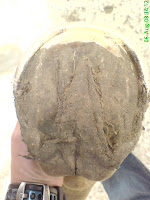




First picture is April 2008, shortly after Madam arrived. There is no collateral groove round the apex of the frog at all, so the horse has very little between the corium and fresh air. This foot is vulnerable to injury and will be uncomfortable or painful over anything but soft surfaces. The second photo shows the foot in August 2008. Mid box rest for sacro illiac injury, its been trimmed at least twice by a qualified farrier. Despite the box rest the shape has improved, but you can see it has a flat thin sole with significant flare and a fungal infection of the frog. It hurts.
Madam's feet are still a work in progress but in the 3-5 pictures you can see the infection is gone, the sole is thicker and her heel buttresses have widened and got much stronger. She has a good heel first landing and is comfortable on lots of surfaces, but not yet large, loose stones over tarmac. I haven't yet dared to send these pictures to the vet who declared that Madam had flat feet (which was true at the time) but was so scathing (ok rude) when I said we could fix that with some decent barefoot trimming and management.
We are still battling flares. We have discovered through trial and error that Madam has chronic metabolic issues. Even a small handful of starchy food, a bit of unsoaked hay or a sniff of grass will compromise her feet. So every time we start to get a good foot we have let her down by giving her the wrong thing to eat. Now we know better we are making much faster progress.
Madam's hind feet were always like a polished glass table. Completely flat with no discernable collateral groove. Well look at them now!










2 comments:
I don't think the differences are subtle, I think they're HUGE and amazing! Bare feet are the best EVER!
:-) Thank you, let's hope they get even better.
Post a Comment